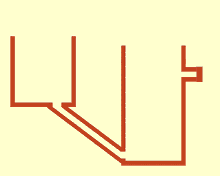Communicating vessels



Communicating vessels are a system of containers or tubes filled with a fluid (usually a liquid) that are connected at the bottom. This system is a fundamental concept in fluid dynamics and hydrostatics, illustrating the principle that, in a state of equilibrium, the fluid will balance out to the same level in all the vessels regardless of their shape or volume, as long as they are connected at the bottom. This phenomenon is based on the principle that the pressure at any given point within a fluid at rest is the same in all directions.
Principle[edit]
The principle of communicating vessels can be explained through the concept of hydrostatic pressure. Hydrostatic pressure is the pressure exerted by a fluid at equilibrium at any given point within the fluid, due to the force of gravity. The pressure at any point in a fluid is given by the equation \(P = \rho gh\), where \(P\) is the pressure, \(\rho\) is the density of the fluid, \(g\) is the acceleration due to gravity, and \(h\) is the height of the fluid column above the point in question.
In a system of communicating vessels, the bottom of all vessels is at the same level, so the pressure at the bottom of each vessel must be the same. Since the pressure depends on the height of the fluid column, the height of the fluid in each vessel must adjust until it is equal in all vessels, regardless of the shape or size of the vessels. This ensures that the pressure at the connecting points (and thus at the bottom of each vessel) is equal.
Applications[edit]
Communicating vessels have various practical applications in both natural and engineered systems. Some examples include:
- Hydraulic systems, where they are used to transmit power or change the direction of force. - Water level management in fields such as agriculture, where systems of ditches and channels can be considered as large-scale communicating vessels. - The design of liquid storage tanks and fuel systems in vehicles, ensuring uniform fuel levels in multiple tanks. - Barometers and manometers, which use the principle of communicating vessels to measure pressure differences.
Limitations[edit]
While the principle of communicating vessels is widely applicable, there are limitations. The principle assumes that the fluid is incompressible and that there is no significant temperature variation across the system that might cause density variations. Additionally, the presence of viscosity and surface tension can affect the exact levels of the fluid in very narrow tubes or in systems with very small openings.
See Also[edit]
- Fluid dynamics - Hydrostatics - Pressure - Hydraulic engineering
Ad. Transform your life with W8MD's Budget GLP-1 injections from $75


W8MD offers a medical weight loss program to lose weight in Philadelphia. Our physician-supervised medical weight loss provides:
- Weight loss injections in NYC (generic and brand names):
- Zepbound / Mounjaro, Wegovy / Ozempic, Saxenda
- Most insurances accepted or discounted self-pay rates. We will obtain insurance prior authorizations if needed.
- Generic GLP1 weight loss injections from $75 for the starting dose.
- Also offer prescription weight loss medications including Phentermine, Qsymia, Diethylpropion, Contrave etc.
NYC weight loss doctor appointmentsNYC weight loss doctor appointments
Start your NYC weight loss journey today at our NYC medical weight loss and Philadelphia medical weight loss clinics.
- Call 718-946-5500 to lose weight in NYC or for medical weight loss in Philadelphia 215-676-2334.
- Tags:NYC medical weight loss, Philadelphia lose weight Zepbound NYC, Budget GLP1 weight loss injections, Wegovy Philadelphia, Wegovy NYC, Philadelphia medical weight loss, Brookly weight loss and Wegovy NYC
|
WikiMD's Wellness Encyclopedia |
| Let Food Be Thy Medicine Medicine Thy Food - Hippocrates |
Medical Disclaimer: WikiMD is not a substitute for professional medical advice. The information on WikiMD is provided as an information resource only, may be incorrect, outdated or misleading, and is not to be used or relied on for any diagnostic or treatment purposes. Please consult your health care provider before making any healthcare decisions or for guidance about a specific medical condition. WikiMD expressly disclaims responsibility, and shall have no liability, for any damages, loss, injury, or liability whatsoever suffered as a result of your reliance on the information contained in this site. By visiting this site you agree to the foregoing terms and conditions, which may from time to time be changed or supplemented by WikiMD. If you do not agree to the foregoing terms and conditions, you should not enter or use this site. See full disclaimer.
Credits:Most images are courtesy of Wikimedia commons, and templates, categories Wikipedia, licensed under CC BY SA or similar.
Translate this page: - East Asian
中文,
日本,
한국어,
South Asian
हिन्दी,
தமிழ்,
తెలుగు,
Urdu,
ಕನ್ನಡ,
Southeast Asian
Indonesian,
Vietnamese,
Thai,
မြန်မာဘာသာ,
বাংলা
European
español,
Deutsch,
français,
Greek,
português do Brasil,
polski,
română,
русский,
Nederlands,
norsk,
svenska,
suomi,
Italian
Middle Eastern & African
عربى,
Turkish,
Persian,
Hebrew,
Afrikaans,
isiZulu,
Kiswahili,
Other
Bulgarian,
Hungarian,
Czech,
Swedish,
മലയാളം,
मराठी,
ਪੰਜਾਬੀ,
ગુજરાતી,
Portuguese,
Ukrainian
